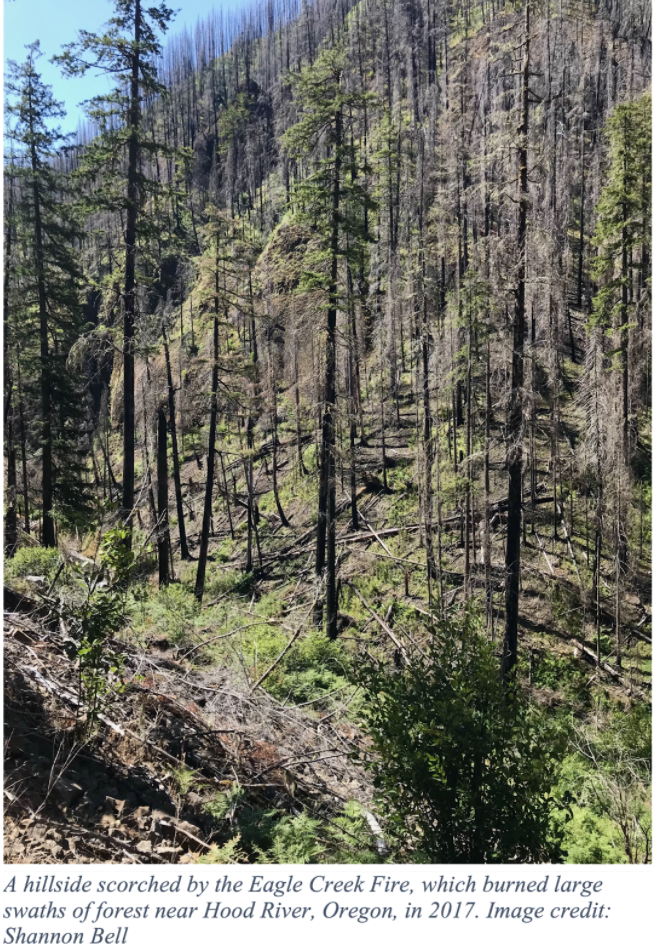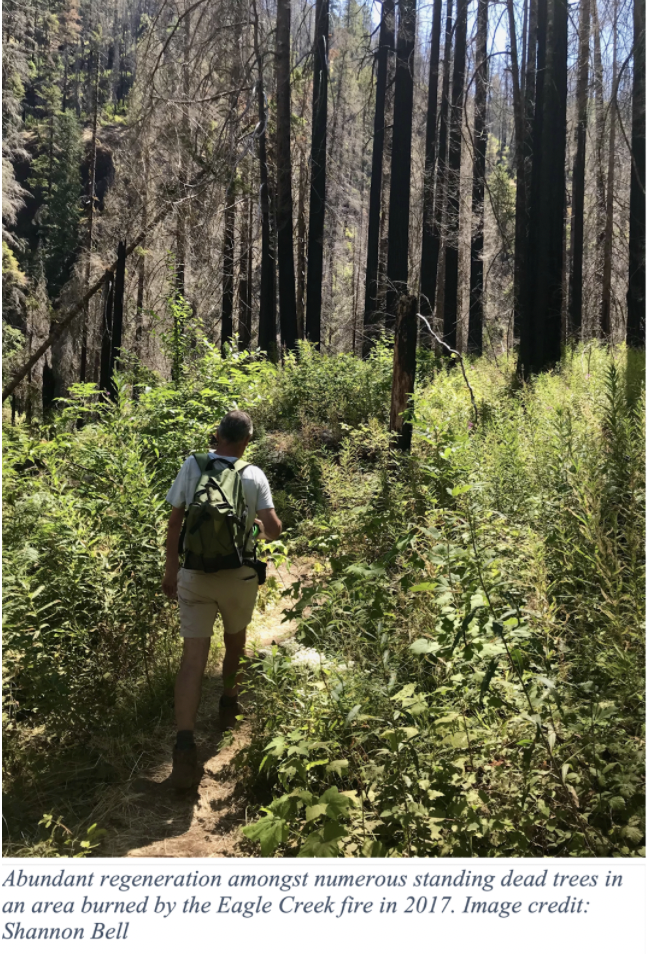In late May of 2021, the Bureau of Land Management (BLM) approved a plan to log over 900 acres of forestland burned in the Holiday Farm Fire, which swept through the landscape in September of 2020 [1]. As a result of a policy change issued by the Trump administration in late 2020, the BLM is permitted to log up to one-third and no more than 5,000 acres of a burned area, as long as that area exceeds 3,000 acres. Since the Holiday Farm Fire burned over 173,000 acres, the BLM, under this policy change, is not required to publish an environmental assessment for the 910-acre harvest [1]. This salvage harvest, like most on U.S. Forest Service and BLM lands, was approved without thorough investigation of potential environmental impacts. The use of categorical exclusions for this type of post-fire timber management has expanded dramatically, releasing the federal government from its duties to investigate environmental impacts of its actions and precluding the public from holding agencies accountable.

In the first two decades of the 21st century, the United States’ public land management agencies have expressed a desire to better incorporate the ecological value of public lands in their management plans. However, change in agency culture requires more than just a change in rhetoric. The approval of salvage logging projects on federal land contradicts previous rule changes and agency statements that explicitly stated the need for more holistic, ecosystem-oriented management. The Biden administration, which has been outspoken on the need for climate change mitigation and conservation, can only reconcile these objectives with its public lands management strategy by prioritizing ecosystem function, actively pursuing environmental justice, and implementing a decision framework that promotes sustainable and just outcomes.
Over 70 percent of BLM and Forest Service lands lie in the West, and in Oregon about 60 percent, or 30.5 million acres, of Oregon’s forests are on federal public lands [2]. These lands have been extensively logged since the late 1800s [3]. With the development of rail lines and new technology, including water-powered sawmills, steam donkeys, and chainsaws, the industry grew rapidly [3]. World War II, however, represented a particularly significant inflection point for the timber industry in the West, and in the years following the war, logging and milling operations exploded [3]. Both public and private foresters began advocating for the logging of old growth forests, arguing that replacing these stands with young, fast growing stands would increase timber harvests [3]. These arguments were met with formidable resistance in the 1970s, as environmentalists took the federal government to court on forest management practices that threatened species protected under the Endangered Species Act [3]. In a key ruling in 1991, Judge William Dwyer gave credence to the arguments of environmentalists, determining that potential spotted owl habitat in national forests must be protected from all logging [3].
Forest Service harvests in Oregon, following Judge Dwyer’s decision, fell from 2 billion board feet in 1990 to 245 million board feet in 2000 [3]. Employment in timber-dependent communities declined significantly along with the harvests, though federal forestland protections are not solely to blame. Increased mechanization of logging and milling operations also played a role [3]. Timber-dependent counties had received 25% of timber harvest revenues from federal forestlands since the early 20th century, but in the span of 4 years from 1989 to 1993, those payments dropped 20% [4]. Congress enacted the Secure Rural Schools and Community Self-Determination Act (SRS) in 2000 as a temporary program, meant to provide more economic stability to these counties and facilitate a transition away from dependence on natural resource extraction [4].
Despite the vision of rural economies less dependent on timber harvest that was presented by SRS, the culture of rural counties and public land management agencies remains tightly tied to extraction. This lingering lust for logging is evident in recent salvage logging decisions, which have been defended based on their economic value, even when they threaten natural regeneration processes. Many forests affected by wildfire, including in large regions of Eastern Oregon, are adapted to frequent, low-severity fire. Fire suppression, which has been practiced across the United States for over a century, has upset the historical species composition of these forests as long periods pass with no opportunity for fire resistant and early successional species to gain an advantage. However, despite fire’s natural existence on the landscape, public land management agencies act on the assumption that it is beneficial for humans to interfere in the post-fire landscape to rehabilitate and restore it [5]. Salvage logging is a large part of what these agencies call sustainable post-fire management and involves removing large trees that are dead or dying because of fire.
Post-fire salvage logging is typically justified because of the economic value it provides, and advocates argue that it can also help prevent subsequent fire [5]. However, these large dying trees targeted in salvage harvests are not principally responsible for wildfire spread; that is attributed to finer fuels like shrubs, grasses, and smaller trees [5]. Even the economic value of these harvests is dubious. The Oregon Department of Forestry’s reforestation plan, drafted after the 2020 wildfires, stated that the total value from salvage harvests cannot be predicted. Timber killed by wildfire can deteriorate quickly, thus decreasing the marketability [6].
While the extent of economic benefits is often unclear, the ecological costs of salvage logging are extensive. Yarding equipment hauled in to transport logs can expose underlying soil and cause compaction, which can greatly increase soil erosion [5]. This disturbance can also inhibit the growth of early successional species, including nitrogen fixers, that provide important nutrient replenishment [5]. The dead and decaying wood removed through salvage logging also provides habitat, nutrients, and structure to riparian and forest ecosystems [5].

In advocating for logging that provides an uncertain amount of economic value but certainly degrades the forest ecosystem and inhibits natural regenerative processes, public land management agencies are perpetuating the use of forests predominantly for their commercial value. The SRS legislation passed in 2000 was meant to be a turning point in the management of federal forestland and the economic foundation of the surrounding rural communities. The Forest Planning Rule in 2012 furthered the notion that federal forestlands should be managed with ecosystem services front of mind. The widespread approval of salvage logging by public agencies under both the Trump and Biden administrations demonstrates the obstinance of agency culture and the persisting inclination to extract as much commercial value from the forests as possible, even under the guise of restoration.
Restoration and rehabilitation have become flexible terms within forest management, allowing public agencies and officials seeking an opportunity to extract value from forestlands to portray their actions as sustainable. To meaningfully uphold and promote the value of ecosystem services in federal forestland, restoration and rehabilitation must be clearly defined in a manner that prioritizes improvements in ecosystem functions, like habitat and clean freshwater provision, carbon sequestration, and protection of biodiversity. Furthermore, there must be clear metrics for the effectiveness of agency actions in protecting and enhancing ecosystem services on public lands. These metrics must be integrated into forest management planning and the system of incentives provided by the county payments that support rural communities. To account for the lack of representation of Indigenous and other marginalized rural communities in previous SRS legislation, federal agencies must ensure that the decision-making framework, the metrics by which decisions are made, and the implementation process are all formulated in collaboration with leaders in these communities. The Biden administration and the United States’ public land management agencies have expressed a clear intent to conserve and protect the ecological value of our nation’s lands. However, if these goals are to be realized, it is imperative that the broad and aspirational rhetoric at the national level is translated into meaningful action at the ecosystem scale.
- Duvernay, A. (June 3, 2021). BLM approves 910-acre salvage harvest in Holiday Farm Fire area. The Register-Guard. Retrieved June 21, 2021, from https://www.registerguard.com/story/news/2021/06/03/blm-approves-910-acre-salvage-tree-harvest-holiday-farm-fire-area/7498377002/
- Vincent, C. H., Bermejo, L. F., & Hanson, L. A. (n.d.). Federal Land Ownership: Overview and Data. 28.
- Robbins, W.G. Timber Industry. Oregon Encyclopedia. Retrieved June 21, 2021, from https://www.oregonencyclopedia.org/articles/timber_industry/#.YNE0lZNKg4h
- Hoover, Katie. “The Secure Rural Schools and Community Self-Determination Act: Background and Issues.” Congressional Research Service (CRS) Reports and Issue Briefs. Washington, DC: Congressional Research Service, 2020. NA. Business Insights: Global. Web. 18 May 2021.
- Beschta, R. L., Rhodes, J. J., Kauffman, J. B., Gresswell, R. E., Minshall, G. W., Karr, J. R., Perry, D. A., Hauer, F. R., & Frissell, C. A. (2004). Postfire Management on Forested Public Lands of the Western United States. Conservation Biology, 18(4), 957–967.
- Poehler, B. (December 1, 2020). Oregon proposes salvage logging 3,600 acres of wildfire-ravaged Santiam State Forest. Statesman Journal. Retrieved June 23, 2021, from https://www.statesmanjournal.com/story/news/2020/12/01/state-proposes-salvage-logging-3-600-wildfire-impacted-forest-acres/6396586002/
Shannon Bell, Western Resource Fellow|Shannon is a Master of Environmental Management candidate at the Yale School of the Environment specializing in environmental policy analysis. She is particularly interested in collaborative policymaking and nature-based climate solutions in the Pacific Northwest, especially in her home state of Oregon. Shannon was inspired to return to the landscape where she was born and raised by both her education in environmental science and climate policy as well as her intimate connection with the diverse forest and highland desert ecosystems. She came to Yale after graduating from the University of British Columbia with a B.S. in Honors Environmental Science. See what Shannon has been up to. | Blog

